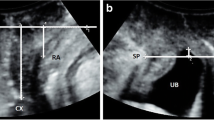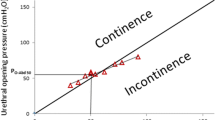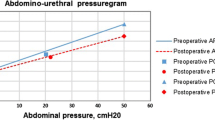Abstract
The objective of this study is to evaluate the effect of anatomic urethral length on the relationship between descent at point Aa of the pelvic organ prolapse quantification (POP-Q) system and the Q-tip straining angle. The records of 323 patients who were evaluated for urinary incontinence were reviewed. Prolapse staging was performed using the POP-Q system. Urethrovesical junction hypermobility defined as a maximal straining angle ≥30° was assessed with the Q-tip test. Urethral length was measured with a urethral profilometer. A substantial correlation was found between descent at point Aa and the straining Q-tip angle (r = 0.65, p < 0.0001). There was no correlation between the anatomic urethral length and straining Q-tip angle (r = −0.01, p = 0.8). Urethral length does not affect the straining Q-tip angle. Point Aa is a strong predictor of an abnormal straining Q-tip angle in women with stage I anterior vaginal wall prolapse or greater.

Similar content being viewed by others
References
Crystle CD, Charme LS, Copeland WE (1971) Q-tip test in stress urinary incontinence. Obstet Gynecol 38:313–315
Noblett K, Lane FL, Driskill CS (2005) Does Pelvic Prolapse Quantification exam predicts urethral mobility in stages 0 and I prolapse. Int Urogynecol J 16:268–271
Cogan SL, Weber AM, Hammel JP (2002) Is urethral mobility really being assessed by the Pelvic Organ Prolapse Quantification (POP-Q) System. Obstet Gynecol 99:473–476
Montella JM, Ewing S, Cater J (1997) Visual assessment of urethrovesical junction mobility. Int Urogynecol J 8:13–17
Matisson MJ, Simisiman AJ, Menefee SA (2006) Can urethral mobility be assessed using the Pelvic Organ Prolapse Quantification system? An analysis of the correlation of between point Aa and Q-tip angle in varying stages of prolapse. Urology 68:1005–1008
Bump RC, Mattison A, Bo K et al (1996) The standardization of terminology of female pelvic organ prolapse and pelvic floor dysfunction. Am J Obstet Gynecol 175:10–17
Karram MM, Bhatia NN (1998) The Q-tip test: standardization of the technique and its interpretation in women with urinary incontinence. Obstet Gynecol 71:807–811
Kenton K, Shott S, Brubaker L (1997) Vaginal topography does not correlate well with visceral position in women with pelvic organ prolapse. Int Urogynecol J 8:336–339
Rosencrantz M, Menefee SA, Lukacz ES (2006) The correlation of urethral mobility and point Aa of the Pelvic Organ Prolapse Quantification system before and after surgery. Obstet Gynecol 195:1841–1845
Pollack TJ, Jenkins P, Kopka SL, Davila GW (2003) Effect of genital prolapse on assessment of bladder neck mobility by the Q-tip test. Obstet Gynecol 101:662–665
Author information
Authors and Affiliations
Corresponding author
Rights and permissions
About this article
Cite this article
Larrieux, J.R., Balgobin, S. Effect of anatomic urethral length on the correlation between the Q-tip test and descent at point Aa of the POP-Q system. Int Urogynecol J 19, 273–276 (2008). https://doi.org/10.1007/s00192-007-0429-2
Received:
Accepted:
Published:
Issue Date:
DOI: https://doi.org/10.1007/s00192-007-0429-2




